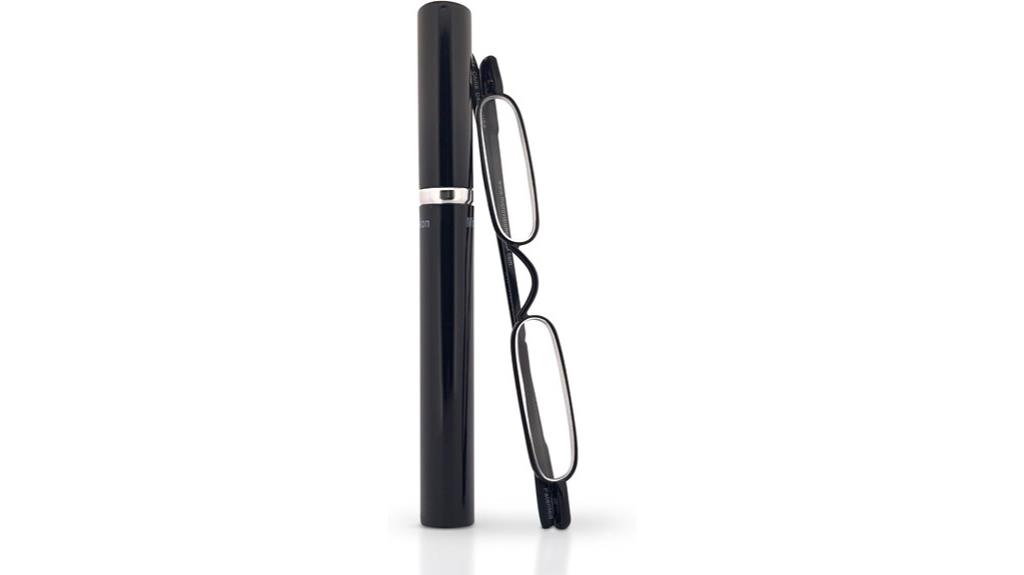For accurate, reliable assay results, I recommend a multimode microplate reader that supports multiple detection methods like absorbance, fluorescence, and luminescence. Look for one with high sensitivity, a broad dynamic range, and robust data analysis features to guarantee precise measurements. High throughput capacity and seamless software integration are also critical for efficient workflows. Keep exploring further to discover how these features can best meet your research needs and improve your experiments.
Key Takeaways
- Look for a multimode reader supporting absorbance, fluorescence, luminescence, and time-resolved detection for versatile assays.
- Prioritize devices with high sensitivity and broad dynamic range to ensure accurate detection of low and high analyte concentrations.
- Ensure compatibility with advanced data analysis software for automated calculations, visualization, and seamless data management.
- Choose high-throughput systems with automated plate handling to accelerate large-scale experiments reliably.
- Confirm easy software integration with LIMS and support across operating systems for streamlined workflow and data sharing.
Original Mini Reader Reading Glasses With Tube Case For Women and Men Lightweight & Portable Eyeglasses

If you’re always on the go and need quick, clear reading glasses, the Original Mini Reader Reading Glasses are an excellent choice. These lightweight, portable glasses feature a microvision patented mini frame, making them pocket-sized and easy to carry in their protective tube case. Crafted from durable stainless steel, they ensure long-lasting use while remaining comfortable for all-day wear. Perfect for indoor and outdoor activities, they let you read computers, maps, labels, and menus effortlessly. Their compact design fits into pockets, purses, or travel bags, so you’re always prepared for sudden reading needs, whether at home or on the move.
Best For: individuals who frequently need quick, portable reading glasses on the go, such as travelers, minimalists, or those with busy lifestyles.
Pros:
- Compact and lightweight design for easy carrying and storage
- Durable stainless steel frame ensures long-lasting use
- Suitable for a variety of indoor and outdoor reading activities
Cons:
- Small size may be difficult for users with larger face shapes or those who prefer full-sized glasses
- May require careful cleaning to maintain lens clarity due to mini design
- Not adjustable, so fit may vary depending on face shape and size
Factors to Consider When Choosing Microplate Readers (Multimode)

When choosing a multimode microplate reader, I focus on how well it supports different detection modes and its sensitivity across various ranges. I also consider how easily the device integrates with data analysis software and handles high throughput. These factors make sure I get reliable results and streamline my workflow efficiently.
Detection Modes Compatibility
Have you ever considered how a microplate reader’s detection mode compatibility can influence your experimental flexibility? It’s essential because versatile readers support multiple detection modes like absorbance, fluorescence, luminescence, and time-resolved measurements. Ideally, a reader should handle several modes either simultaneously or sequentially, allowing you to perform diverse assays without switching equipment. Keep in mind, each detection mode has different sensitivity and dynamic range requirements, so verifying compatibility with your specific signals is vital. Some models even feature customizable optical filters and dichroic mirrors, enhancing detection precision across modes. This compatibility directly impacts your ability to develop complex, multiplexed, or multi-parametric assays efficiently, ultimately broadening your research capabilities and streamlining workflows.
Sensitivity and Range
Choosing the right microplate reader involves carefully balancing sensitivity and range to meet your specific assay needs. Sensitivity affects how well the device detects low analyte concentrations, which is crucial for accurate results. Achieving high sensitivity often depends on advanced optical components like sensitive detectors and optimized filters that reduce noise. On the other hand, the dynamic range shows the span of concentrations the reader can measure accurately without dilution, making it versatile for different sample types. A broad measurement range reduces the need for multiple dilutions, streamlining workflows. Balancing these factors ensures you can detect low-level signals precisely while handling a wide variety of sample concentrations, ultimately delivering reliable and consistent assay results tailored to your specific research or diagnostic requirements.
Data Analysis Features
Selecting a microplate reader with robust data analysis features can substantially improve the accuracy and efficiency of your experiments. These features automate calculations like normalization, blank subtraction, and curve fitting, reducing manual errors and boosting reproducibility. Advanced data processing capabilities allow for real-time monitoring and multi-parameter analysis, giving you a thorough view of assay performance. Compatibility with specialized software enhances data visualization, statistical analysis, and easy report generation, streamlining your workflow. The ability to export raw and processed data in formats like CSV, Excel, or PDF ensures seamless integration into your lab’s data management system. Overall, strong data analysis features help you derive meaningful insights faster while maintaining consistency and precision in your assay results.
Throughput Capacity
When evaluating microplate readers, throughput capacity is a critical factor because it directly influences how efficiently you can process large numbers of samples. Higher throughput systems allow for faster data acquisition, which is essential for large-scale experiments or screening processes. The capacity often depends on the reader’s ability to handle multiple plates simultaneously or quickly switch between plates. Automated plate handling and stacking features can considerably boost throughput without compromising measurement accuracy. Choosing a system with the right throughput capacity depends on your sample volume and how quickly you need results. If your workload involves processing hundreds or thousands of samples regularly, investing in a high-throughput reader can save time and improve overall lab productivity.
Software Integration Ease
Ease of software integration plays a essential role in ensuring that your microplate reader works smoothly within your laboratory’s existing digital infrastructure. Seamless data transfer to laboratory information management systems (LIMS) is fundamental for efficient workflow and accurate results. Compatibility with common operating systems like Windows, macOS, and Linux simplifies setup and reduces delays. Support for standardized data formats such as SD, ASCII, or XML makes sharing and analyzing data across platforms straightforward. A user-friendly interface and minimal configuration requirements enable quick setup and less reliance on technical support. Additionally, regular software updates and dedicated technical support enhance integration stability and keep your system compatible with evolving laboratory workflows. This ease of integration ultimately saves time and minimizes disruptions.
Cost and Maintenance
Cost and maintenance are important factors to contemplate when choosing a multimode microplate reader. The initial price can vary considerably, from around $10,000 to over $50,000, depending on features. Ongoing expenses include calibration, lamp replacements, and software updates, which can add up to several thousand dollars annually. Selecting a model built with durable components and reliable support helps reduce long-term costs and minimizes downtime. Be aware that some readers require specialized consumables and reagents, increasing operational expenses. Proper maintenance and regular servicing are essential to ensure peak performance and extend the equipment’s lifespan. While upfront costs are important, considering maintenance, consumables, and support will help you choose a device that offers the best value over time.
Frequently Asked Questions
What Is the Lifespan of a Typical Multimode Microplate Reader?
A typical multimode microplate reader lasts around 5 to 10 years, depending on usage and maintenance. I’ve seen well-maintained devices perform reliably for over a decade, but frequent use and improper care can abbreviate that lifespan. Regular calibration, cleaning, and following manufacturer guidelines help extend its life. Investing in quality and proper upkeep ensures your reader remains accurate and dependable throughout its years of service.
Can Microplate Readers Be Used for Both Colorimetric and Fluorescent Assays?
Yes, microplate readers can be used for both colorimetric and fluorescent assays. I’ve found that multimode readers are versatile, allowing me to switch easily between different detection modes. They’re ideal for various experiments because they accommodate multiple assay types without needing separate instruments. This flexibility saves me time and resources, making my workflow more efficient and ensuring I get accurate, reliable results across different assay formats.
Are There Portable Microplate Readers Suitable for Field Research?
Imagine carrying a tiny lighthouse for your research—yes, there are portable microplate readers perfect for fieldwork. I’ve used compact devices that fit in a backpack, shining bright with reliable results. These portable readers are ideal when you need quick, accurate measurements outside the lab. They’re a game-changer, offering flexibility without sacrificing precision, making your field research more efficient and effective than ever before.
How Do Maintenance Requirements Vary Between Different Multimode Models?
Maintenance needs differ quite a bit between multimode microplate models. Some require regular calibration, cleaning, and software updates, while others have more automated processes that reduce upkeep. I’ve found that high-end models often come with user-friendly maintenance features, making routine care simpler. Lower-end options may need more manual attention, so I always recommend checking each model’s maintenance guidelines to guarantee reliable performance and longevity.
What Are the Common Troubleshooting Steps for Inaccurate Readings?
When I encounter inaccurate readings, I first check for proper calibration and confirm the instrument is clean, especially the optical components. I also verify that the plates are correctly loaded and free of bubbles or debris. If issues persist, I review the software settings and run control samples. Regular maintenance, like lamp replacement and cleaning, helps prevent these problems and keeps my readings consistent.
Conclusion
Choosing the right multimode microplate reader is like finding a reliable compass—it guides your assays with precision and confidence. By considering detection modes, sensitivity, data analysis, and cost, you can select a device that truly fits your needs. Don’t rush; the right tool makes your experiments feel like a walk in the park, smooth and predictable. Invest wisely, and you’ll guarantee your results are accurate, reliable, and ready to propel your research forward.









